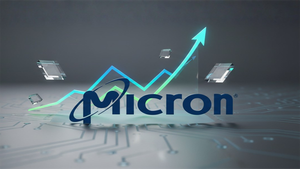
The relentless pursuit of artificial intelligence (AI) and high-performance computing (HPC) by Big Tech giants has ignited an unprecedented demand for advanced semiconductors, ushering in what many are calling the "AI Supercycle." At the forefront of this revolution stands Nvidia (NASDAQ: NVDA), whose specialized Graphics Processing Units (GPUs) have become the indispensable backbone for training and deploying the most sophisticated AI models. This insatiable appetite for computational power is not only straining global manufacturing capacities but is also dramatically accelerating innovation in chip design, packaging, and fabrication, fundamentally reshaping the entire semiconductor industry.
As of late 2025, the impact of these tech titans is palpable across the global economy. Companies like Amazon (NASDAQ: AMZN), Microsoft (NASDAQ: MSFT), Google (NASDAQ: GOOGL), Apple (NASDAQ: AAPL), and Meta (NASDAQ: META) are collectively pouring hundreds of billions into AI and cloud infrastructure, translating directly into soaring orders for cutting-edge chips. Nvidia, with its dominant market share in AI GPUs, finds itself at the epicenter of this surge, with its architectural advancements and strategic partnerships dictating the pace of innovation and setting new benchmarks for what's possible in the age of intelligent machines.
The Engineering Frontier: Pushing the Limits of Silicon
The technical underpinnings of this AI-driven semiconductor boom are multifaceted, extending from novel chip architectures to revolutionary manufacturing processes. Big Tech's demand for specialized AI workloads has spurred a significant trend towards in-house custom silicon, a direct challenge to traditional chip design paradigms.
Google (NASDAQ: GOOGL), for instance, has unveiled its custom Arm-based CPU, Axion, for data centers, claiming substantial energy efficiency gains over conventional CPUs, alongside its established Tensor Processing Units (TPUs). Similarly, Amazon Web Services (AWS) (NASDAQ: AMZN) continues to advance its Graviton processors and specialized AI/Machine Learning chips like Trainium and Inferentia. Microsoft (NASDAQ: MSFT) has also entered the fray with its custom AI chips (Azure Maia 100) and cloud processors (Azure Cobalt 100) to optimize its Azure cloud infrastructure. Even OpenAI, a leading AI research lab, is reportedly developing its own custom AI chips to reduce dependency on external suppliers and gain greater control over its hardware stack. This shift highlights a desire for vertical integration, allowing these companies to tailor hardware precisely to their unique software and AI model requirements, thereby maximizing performance and efficiency.
Nvidia, however, remains the undisputed leader in general-purpose AI acceleration. Its continuous architectural advancements, such as the Blackwell architecture, which underpins the new GB10 Grace Blackwell Superchip, integrate Arm (NASDAQ: ARM) CPUs and are meticulously engineered for unprecedented performance in AI workloads. Looking ahead, the anticipated Vera Rubin chip family, expected in late 2026, promises to feature Nvidia's first custom CPU design, Vera, alongside a new Rubin GPU, projecting double the speed and significantly higher AI inference capabilities. This aggressive roadmap, marked by a shift to a yearly release cycle for new chip families, rather than the traditional biennial cycle, underscores the accelerated pace of innovation directly driven by the demands of AI. Initial reactions from the AI research community and industry experts indicate a mixture of awe and apprehension; awe at the sheer computational power being unleashed, and apprehension regarding the escalating costs and power consumption associated with these advanced systems.
Beyond raw processing power, the intense demand for AI chips is driving breakthroughs in manufacturing. Advanced packaging technologies like Chip-on-Wafer-on-Substrate (CoWoS) are experiencing explosive growth, with TSMC (NYSE: TSM) reportedly doubling its CoWoS capacity in 2025 to meet AI/HPC demand. This is crucial as the industry approaches the physical limits of Moore's Law, making advanced packaging the "next stage for chip innovation." Furthermore, AI's computational intensity fuels the demand for smaller process nodes such as 3nm and 2nm, enabling quicker, smaller, and more energy-efficient processors. TSMC (NYSE: TSM) is reportedly raising wafer prices for 2nm nodes, signaling their critical importance for next-generation AI chips. The very process of chip design and manufacturing is also being revolutionized by AI, with AI-powered Electronic Design Automation (EDA) tools drastically cutting design timelines and optimizing layouts. Finally, the insatiable hunger of large language models (LLMs) for data has led to skyrocketing demand for High-Bandwidth Memory (HBM), with HBM3E and HBM4 adoption accelerating and production capacity fully booked, further emphasizing the specialized hardware requirements of modern AI.
Reshaping the Competitive Landscape
The profound influence of Big Tech and Nvidia on semiconductor demand and innovation is dramatically reshaping the competitive landscape, creating clear beneficiaries, intensifying rivalries, and posing potential disruptions across the tech industry.
Companies like TSMC (NYSE: TSM) and Samsung Electronics (KRX: 005930), leading foundries specializing in advanced process nodes and packaging, stand to benefit immensely. Their expertise in manufacturing the cutting-edge chips required for AI workloads positions them as indispensable partners. Similarly, providers of specialized components, such as SK Hynix (KRX: 000660) and Micron Technology (NASDAQ: MU) for High-Bandwidth Memory (HBM), are experiencing unprecedented demand and growth. AI software and platform companies that can effectively leverage Nvidia's powerful hardware or develop highly optimized solutions for custom silicon also stand to gain a significant competitive edge.
The competitive implications for major AI labs and tech companies are profound. While Nvidia's dominance in AI GPUs provides a strategic advantage, it also creates a single point of dependency. This explains the push by Google (NASDAQ: GOOGL), Amazon (NASDAQ: AMZN), and Microsoft (NASDAQ: MSFT) to develop their own custom AI silicon, aiming to reduce costs, optimize performance for their specific cloud services, and diversify their supply chains. This strategy could potentially disrupt Nvidia's long-term market share if custom chips prove sufficiently performant and cost-effective for internal workloads. For startups, access to advanced AI hardware remains a critical bottleneck. While cloud providers offer access to powerful GPUs, the cost can be prohibitive, potentially widening the gap between well-funded incumbents and nascent innovators.
Market positioning and strategic advantages are increasingly defined by access to and expertise in AI hardware. Companies that can design, procure, or manufacture highly efficient and powerful AI accelerators will dictate the pace of AI development. Nvidia's proactive approach, including its shift to a yearly release cycle and deepening partnerships with major players like SK Group (KRX: 034730) to build "AI factories," solidifies its market leadership. These "AI factories," like the one SK Group (KRX: 034730) is constructing with over 50,000 Nvidia GPUs for semiconductor R&D, demonstrate a strategic vision to integrate hardware and AI development at an unprecedented scale. This concentration of computational power and expertise could lead to further consolidation in the AI industry, favoring those with the resources to invest heavily in advanced silicon.
A New Era of AI and Its Global Implications
This silicon supercycle, fueled by Big Tech and Nvidia, is not merely a technical phenomenon; it represents a fundamental shift in the broader AI landscape, carrying significant implications for technology, society, and geopolitics.
The current trend fits squarely into the broader narrative of an accelerating AI race, where hardware innovation is becoming as critical as algorithmic breakthroughs. The tight integration of hardware and software, often termed hardware-software co-design, is now paramount for achieving optimal performance in AI workloads. This holistic approach ensures that every aspect of the system, from the transistor level to the application layer, is optimized for AI, leading to efficiencies and capabilities previously unimaginable. This era is characterized by a positive feedback loop: AI's demands drive chip innovation, while advanced chips enable more powerful AI, leading to a rapid acceleration of new architectures and specialized hardware, pushing the boundaries of what AI can achieve.
However, this rapid advancement also brings potential concerns. The immense power consumption of AI data centers is a growing environmental issue, making energy efficiency a critical design consideration for future chips. There are also concerns about the concentration of power and resources within a few dominant tech companies and chip manufacturers, potentially leading to reduced competition and accessibility for smaller players. Geopolitical factors also play a significant role, with nations increasingly viewing semiconductor manufacturing capabilities as a matter of national security and economic sovereignty. Initiatives like the U.S. CHIPS and Science Act aim to boost domestic manufacturing capacity, with the U.S. projected to triple its domestic chip manufacturing capacity by 2032, highlighting the strategic importance of this industry. Comparisons to previous AI milestones, such as the rise of deep learning, reveal that while algorithmic breakthroughs were once the primary drivers, the current phase is uniquely defined by the symbiotic relationship between advanced AI models and the specialized hardware required to run them.
The Horizon: What's Next for Silicon and AI
Looking ahead, the trajectory set by Big Tech and Nvidia points towards an exciting yet challenging future for semiconductors and AI. Expected near-term developments include further advancements in advanced packaging, with technologies like 3D stacking becoming more prevalent to overcome the physical limitations of 2D scaling. The push for even smaller process nodes (e.g., 1.4nm and beyond) will continue, albeit with increasing technical and economic hurdles.
On the horizon, potential applications and use cases are vast. Beyond current generative AI models, advanced silicon will enable more sophisticated forms of Artificial General Intelligence (AGI), pervasive edge AI in everyday devices, and entirely new computing paradigms. Neuromorphic chips, inspired by the human brain's energy efficiency, represent a significant long-term development, offering the promise of dramatically lower power consumption for AI workloads. AI is also expected to play an even greater role in accelerating scientific discovery, drug development, and complex simulations, powered by increasingly potent hardware.
However, significant challenges need to be addressed. The escalating costs of designing and manufacturing advanced chips could create a barrier to entry, potentially limiting innovation to a few well-resourced entities. Overcoming the physical limits of Moore's Law will require fundamental breakthroughs in materials science and quantum computing. The immense power consumption of AI data centers necessitates a focus on sustainable computing solutions, including renewable energy sources and more efficient cooling technologies. Experts predict that the next decade will see a diversification of AI hardware, with a greater emphasis on specialized accelerators tailored for specific AI tasks, moving beyond the general-purpose GPU paradigm. The race for quantum computing supremacy, though still nascent, will also intensify as a potential long-term solution for intractable computational problems.
The Unfolding Narrative of AI's Hardware Revolution
The current era, spearheaded by the colossal investments of Big Tech and the relentless innovation of Nvidia (NASDAQ: NVDA), marks a pivotal moment in the history of artificial intelligence. The key takeaway is clear: hardware is no longer merely an enabler for software; it is an active, co-equal partner in the advancement of AI. The "AI Supercycle" underscores the critical interdependence between cutting-edge AI models and the specialized, powerful, and increasingly complex semiconductors required to bring them to life.
This development's significance in AI history cannot be overstated. It represents a shift from purely algorithmic breakthroughs to a hardware-software synergy that is pushing the boundaries of what AI can achieve. The drive for custom silicon, advanced packaging, and novel architectures signifies a maturing industry where optimization at every layer is paramount. The long-term impact will likely see a proliferation of AI into every facet of society, from autonomous systems to personalized medicine, all underpinned by an increasingly sophisticated and diverse array of silicon.
In the coming weeks and months, industry watchers should keenly observe several key indicators. The financial reports of major semiconductor manufacturers and Big Tech companies will provide insights into sustained investment and demand. Announcements regarding new chip architectures, particularly from Nvidia (NASDAQ: NVDA) and the custom silicon efforts of Google (NASDAQ: GOOGL), Amazon (NASDAQ: AMZN), and Microsoft (NASDAQ: MSFT), will signal the next wave of innovation. Furthermore, the progress in advanced packaging technologies and the development of more energy-efficient AI hardware will be crucial metrics for the industry's sustainable growth. The silicon supercycle is not just a temporary surge; it is a fundamental reorientation of the technology landscape, with profound implications for how we design, build, and interact with artificial intelligence for decades to come.
This content is intended for informational purposes only and represents analysis of current AI developments.
TokenRing AI delivers enterprise-grade solutions for multi-agent AI workflow orchestration, AI-powered development tools, and seamless remote collaboration platforms.
For more information, visit https://www.tokenring.ai/.






